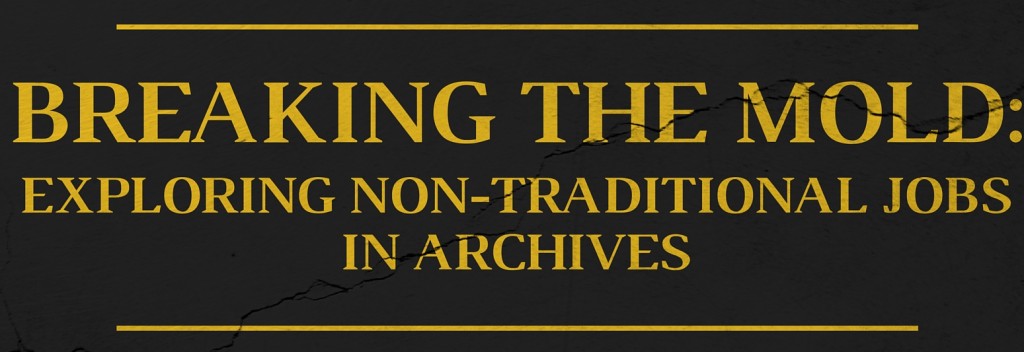SLA/SCoSAA co-hosted a conversation between three non-traditional archivists,forming a panel called “Breaking the Mold: Jobs In Non Traditional Archives.” The event was held on Tuesday, March 22, from 4:30-5:30 PM in the Kotzen Room on the Simmons campus. The three archivists were recorded, and we will share the link to the online version of the presentation as soon as we can.
The panelists included Stefanie Maclin-Hurd, a Software as a Service Catalog Specialist at EBSCO and the Special Library Associations New England Immediate Past-President; Joy McNally Brandow, the Research Support Coordinator for the Union of Concerned Scientists and the SLA New England President-Elect; and Heather Mumford, the Archivist for the Harvard T.H. Chan School of Public Health. Each panelist spoke briefly about herself, her background, and her current line of working. Stefanie started, explaining that she works primarily with academic databases. After graduating from Simmons, she anticipated taking a more traditional role in an archives, but discovered she was allergic to mold. She worked in an academic atmosphere for a while, and then transitioned to this role, which she finds makes use of a lot of archives skills in a non-archives environment. She works mostly with MARC records and metadata every day, and helps libraries move between AACR2 and RDA, make choices about subject headings, and other related cataloging tasks. She works with different types of libraries internationally, and finds that the overall atmosphere, though in a corporate setting, includes nearly all employees with library science, often with archives focuses, degrees.
Joy explained, “When you’re done at Simmons, its ok to not have archives or librarian in your title. You can still be part of the profession.” She has worked in corporate settings and is now the sole archivist for a non-profit. She finds herself helping researchers locate information, providing technical services, and basically, being an archivist, without the title. She gave the example of a recent project for the organizations 175th anniversary, for which she cataloged 1000 fire sprinklers not what one anticipates doing, but researchers have already said having that organization will allow them to do work and make changes to existing and future sprinklers. She said, You cant look for the title, you have to look for the job description. She also addressed the fact that many libraries, especially beyond academic institutions, are very small, and have solo practitioners like her working for them. She thus is a big part of professional organizations and makes an effort to interact and meet up with fellow librarians and members of her work community.
Heather then spoke about her experience after graduating from Simmons, which at first led her to records management, which opened the door to her current role, which involves exhibits, donors and building longer relationships (lots of lunches and coffees), as she is really more on the acquisitions side of the archives picture, and has records management duties. She says, Its both awesome and scary. The institution where she works, the Center for the History of Medicine, is a large one, with archivists who are specialized some are processors, some handle objects, rare books, and some, like her, handle acquisitions. Heather also made the recommendation that Simmons students figure out what we really like doing in archives or libraries, and think about how that can be applied more broadly. For her, this had started out as the fact that, with a background in teaching and theater, she wasn’t sure she loved the processing archivists day in, day out experience. She wanted more interactions, and found that records management felt like the right fit she would be going into offices, working with and talking to people, and that has only increased when she was appointed to this role.
Students were then given the chance to ask questions, and several themes emerged in the ongoing conversation. For each of the speakers, it was important that what they were doing made use of the skills they had learned as a Simmons library and information science student, including many of the particular archives skills. They also emphasized thinking beyond the box in terms of job titles, and instead searching job descriptions for words like cataloger, metadata, DAMS, content designer, manager, or curator, and things like, in order to find the corporate, nonprofit, or other non-traditional roles. They also listed numerous professional organizations beyond NEA and SLA, including ALA, SAA, AIM, MLA, APHA, ALHHS, and others–each of these organizations suits different jobs in different ways, but, as always, networking was a key part of them finding their current roles, and they all encouraged everyone to think broadly about job and networking opportunities alike.
